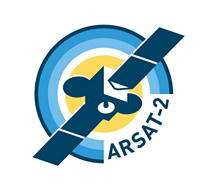ARSAT-2
 ARSAT-2 in INVAP. | |||||
| Mission type | Communication | ||||
|---|---|---|---|---|---|
| Operator | ARSAT | ||||
| COSPAR ID | 2015-054B[1] | ||||
| SATCAT № | 40941[1] | ||||
| Mission duration | 15 years | ||||
| Spacecraft properties | |||||
| Spacecraft | ARSAT-2 | ||||
| Bus | ARSAT-3K[2] | ||||
| Manufacturer |
INVAP Thales Alenia Space | ||||
| Launch mass | 2,977 kilograms (6,563 lb)[3] | ||||
| Power | 4,600 W[4] | ||||
| Start of mission | |||||
| Launch date | 20:30, September 30, 2015 (UTC)[5] | ||||
| Rocket | Ariane 5ECA | ||||
| Launch site | Kourou ELA-3 | ||||
| Contractor | Arianespace | ||||
| Orbital parameters | |||||
| Reference system | Geocentric | ||||
| Regime | Geostationary | ||||
| Longitude | 81° West | ||||
| Transponders | |||||
| Band | 20 (24 36Mhz equivalent) IEEE Ku band and 6 (13 36Mhz equivalent) IEEE C band transponders[2] | ||||
| Frequency | Ku band and C band | ||||
| Bandwidth |
Ku band: 864 Mhz C band: 464 Mhz | ||||
| Coverage area | North and South America | ||||
|
| |||||
ARSAT-2 is a geostationary communications satellite operated by ARSAT and built by the Argentine company INVAP.[6] It was launched from French Guiana alongside Sky Muster satellite using an Ariane 5ECA rocket on September 30, 2015 at 20:30hs UTC, becoming the 400th satellite to be launched by Arianespace.[7][8] It is licensed to be located at 81° West longitude geostationary slot.[9][10] ARSAT-2 is the second geostationary satellite built in Latin America, after ARSAT-1. Structurally and mechanically it is a copy of the ARSAT-1, the only difference being the payload and thus it has different antenna configuration.[11][2]
Payload
ARSAT-2 payload was supplied by Thales Alenia Space of France. It consists of both Ku band and C band sections.[2]
The Ku band has 20 physical transponders. Of those, sixteen have a 36 MHz bandwidth and four have 72 MHz. Thus the satellite has a maximum capacity of 864 MHz Ku or 24 transponder equivalent. A 2 m (6.6 ft) deployable antenna and a 1.3 m (4.3 ft) fixed Gregorian antenna.[2]
The C band section has a single 1.6 m (5.2 ft) deployable antenna that is fed by six physical transponders. Four have 72Mhz of bandwidth and the other two have 88 MHz. The total available C Band bandwidth is thus 464 MHz (or 12.9 transponder equivalent).[2]
See also
References
- 1 2 "TLE Search". www.space-track.org. 2015-10-02. Retrieved 2015-10-02.
- 1 2 3 4 5 6 Belluscio, Alejandro G. (2015-09-21). "ARSAT-2: Argentina consolidates as Latin American satellite leader". NASA SpaceFlight. Retrieved 2015-10-01.
- ↑ Ariane 5 Flight VA226 - Launch kit (PDF). Arianespace Service & Solutions. September 2015. Retrieved 2015-09-22.
- ↑ Flight Ariane 226 - Launch kit (PDF). Airbus Defense & Space. September 2015. Retrieved 2015-09-29.
- ↑ Bergin, Chris (2015-09-30). "Ariane 5 conducts dual launch for Australia and Argentina". NASA SpaceFlight. Retrieved 2015-10-01.
- ↑ "ARSAT Satellites". INVAP. Retrieved 2015-08-24.
- ↑ "El Arsat-2 va rumbo a la Guayana francesa para ser lanzado al espacio" [The Arsat-2 going to French Guaiana for space launch] (in Spanish). Telam. 2015-08-18. Retrieved 2015-08-24.
- ↑ Clark, Stephen (2015-09-30). "Live coverage: Ariane 5 rocket soars with Sky Muster, Arsat 2". SpaceFlightNow.com. Retrieved 2015-10-01.
- ↑ "Aprueban la posición orbital para el satélite Arsat 2" [Arsat-2 orbital slot approved] (in Spanish). Telam. 2015-06-11. Retrieved 2015-08-24.
- ↑ EMPRESA ARGENTINA DE SOLUCIONES SATELITALES, Resolution No. 22/2015 SECRETARIA DE COMUNICACIONES of 2015-06-08 (in Spanish). Retrieved on 2015-08-25.
- ↑ "Diseño y fabricación" [Design and Manufacturing] (in Spanish). ARSAT S.A. Retrieved 2015-08-24.
External links
- SATÉLITES ARSAT (Spanish)
